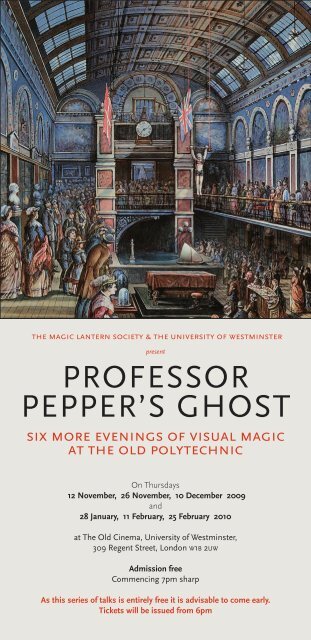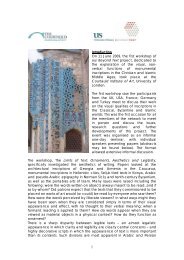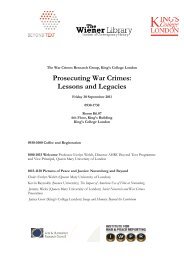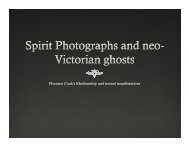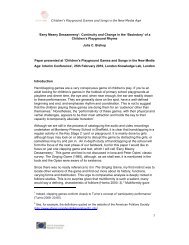PROFESSOR PEPPER'S GHOST - Projects
PROFESSOR PEPPER'S GHOST - Projects
PROFESSOR PEPPER'S GHOST - Projects
You also want an ePaper? Increase the reach of your titles
YUMPU automatically turns print PDFs into web optimized ePapers that Google loves.
the magic lantern society & the university of westminsterpresent<strong>PROFESSOR</strong>PEPPER’S <strong>GHOST</strong>six more evenings of visual magicat the old polytechnicOn Thursdays12 November, 26 November, 10 December 2009and28 January, 11 February, 25 February 2010at The Old Cinema, University of Westminster,309 Regent Street, London W1B 2UWAdmission freeCommencing 7pm sharpAs this series of talks is entirely free it is advisable to come early.Tickets will be issued from 6pm
INTRODUCTIONFor over forty years (1838–81) the Royal Polytechnic was London’sbest known institution dedicated to the popularisation of science.Its most popular attraction was the optical theatre where audienceswere introduced to the latest breakthroughs in visual technology, artistryand performance – the wonders of the magic lantern, panorama,diorama, stereoscope and the popular stage illusion, ‘Pepper’s Ghost’,named after the institution’s avuncular director Professor Pepper.These one-hour talks and events aim to celebrate the spirit of theold Polytechnic featuring rarely-seen London-based historical material,physical demonstrations of ‘lost media’ and surprising new applicationsof ancient optical techniques.THE PROGRAMMEThursday 12 November, 7pmPhantasmagoria-mania‘Professor’ Mervyn HeardIn 1801 the mysterious foreign magician Paul de Philipsthal materialisedon the London theatre scene with his extraordinary Gothic ghost showentertainment, the Phantasmagoria. This is a full-blooded and oftenbizarre illustrated account of the show’s success in London and theprovinces, traced through the surviving posters and advertisementsof the period.Mervyn Heard creates magic lantern entertainments using originallantern slide material and by drawing on original research. He hasdevised projects and performances for venues worldwide and in 2007designed a phantasmagoria instillation for the Gothic Nightmaresexhibition at the Tate. He is also the author of Phantasmagoria:The Secret Life of the Magic Lantern and currently Chairmanof the Magic Lantern Society. www.heard.supanet.com
Thursday 26 November, 7pmLavater: the Shadow of HistorySimon WarnerThe noted physiognomist Johann Caspar Lavater (1741–1801) returnsfor one night only to reclaim his place at the centre of European culture,armed with magic lantern, silhouette apparatus and a curious tale ofphotographic experimentation in his Zürich cellar. Lavater’s influentialEssays on Physiognomy created a fashion for silhouette portraiture inthe early 1800s that outlasted his arcane theories and establish himas a prototype photographer.Simon Warner is a photographer, video artist and researcher withinterests in the history of photography and visual media. With a NESTAFellowship he has created a series of impersonations of key figures inEuropean culture: Goethe, Daguerre, Lavater and Herschel, and tookpart in the Arts Council England touring exhibition Alchemy (2006–7).Recent projects include Victorian photography workshops for theBrontë Parsonage and Florence Nightingale Museums, and silhouettedrawing installations for The Last Tuesday Society and The Houseof Fairy Tales.www.simonwarner.co.uk
Thursday 10 December, 7pmGrappling with Ghosts: Staging Ghost Effects in the Modern TheatrePaul KieveSince a very young age, Paul Kieve has been fascinated by Pepper’sGhost and, as a leading designer of theatre effects, he has now hadseveral opportunities to dabble with the infamous apparition. Hispersonal journey has led to hours in dark theatres, expensive quotesfrom Pilkington’s glass, ill-tempered opera singers in Hamburg andperhaps the world’s first ghost doves. This talk explores the fascinatingtale of how the original impractical Dircksian Phantasmagoria of the1850s came into its own in the 1860s and how, even with hugeadvancement in stage engineering and lighting, it is still spookilydifficult to stage.Paul Kieve is one of the UK’s most prolific designers of theatricalillusions (The Lord of the Rings, Zorro, The Invisible Man).He is the only magician to appear in and consult on the HarryPotter movies and is the author of the internationally published bookHocus Pocus. His current projects include Zorro at The Folies Bergerein Paris and the forthcoming musical Ghost.www.stageillusion.comCHRISTMAS BREAKThursday 28th January, 7pmVisualising the Marvellous: G.A.Smith and his film Santa Claus(1898)Dr Frank GrayG.A.Smith (1864–59) was one of the great early film pioneers.A stage mesmerist and an associate of the Society for PsychicalResearch, his six ‘spooky’ films of 1898 represent his fascinationwith the ‘other side’ and his close association with late-Victorianparanormal culture. The series featured ghosts, telepathy, fairies,the devil, transformations and visions. Its only survivor is SantaClaus. In it, Santa fills the children’s stockings with presents andthen … vanishes. This was a simple and effective demonstrationof the new medium’s ability to create an image of wonder.Dr Frank Gray is the Director of Screen Archive South East at theUniversity of Brighton and a specialist in late-Victorian cinema. He haswritten and lectured widely on the two key members of the ‘BrightonSchool’: the film-makers George Albert Smith and James Williamson.www.brighton.ac.uk / screenarchive
Thursday 11 February, 7pmGeared to the Stars: Victorian Astronomy through the Magic LanternMark ButterworthLectures on astronomy were a commonform of popular entertainment in the19th century. With an original Victorianmagic lantern projector and delicate,hand-painted glass slides from the1840s, Mark Butterworth recreatesone of these illustrated lectures.Using complex and intricatemechanical ‘rackwork’ slidesto illustrate astronomical concepts,it gives an introduction to mid-19th century astronomy. The lecturesummarises the knowledge of the time and presents an entertainingguide to the most interesting phenomena in the night sky.Mark Butterworth researches astronomical history and specialisesin understanding how popular astronomy was presented to thegeneral public in the 18th and 19th century. He is a Fellow of theRoyal Astronomical Society. www.markbutterworth.co.ukThursday 25 February, 7pmFrom Anorthoscope to Zoopraxiscope:an A-Z of Victorian Animated CartoonsStephen HerbertMoving image 19th-century ‘toys’ – philosophical instruments for thedrawing room, intended to promote intellectual discussion and provideamusement for adults as least as much as for children – come to lifewith this illustrated talk. Zoetropes, praxinoscopes, phenakistoscopes ...they didn’t believe in easy names in those days. Why was computerpioneer Charles Babbage furious about a simple cardboard toy?Why do 13 monkeys need only 12 hats? Who was making cartoonmovies before the first ‘live-action’ films?In the 1860s–70s, a generation before ‘cinema’, ProfessorPepper delighted audiences at the Royal Polytechnic withdemonstrations of these new Victorianmotion-picture marvels. With this talk,Stephen Herbert, who has had a lifelongfascination with the subject,explores its social, political, economic,aesthetic and perceptual aspects,demonstrating the effects andrevealing new research.Stephen Herbert is a Visiting ResearchFellow, Faculty of Art, Design &Architecture, Kingston UniversityLondon. www.stephenherbert.co.uk
The Magic Lantern Society has a world-wide membershipof collectors, enthusiasts, students of film and visual media andpopular culture, magicians, art historians, performers, scientists andarchival organisations from over 30 different countries – all sharingthe same interest in the magic lantern and its history. The Societyis not only interested in the lantern, or in the past. Member interestsare broad, covering other ‘lost’ forms of visual media and opticaldiversions, as well as their 21st-century counterparts.The Society runs a lively programme of lectures and showsin Britain and an international convention every four years as wellas visits to major exhibitions and archive collections. It publishesquarterly newsletters outlining member activities and journals ofrecent research and issues tapes and DVDs of meetings. It offersspecial deals on a wide range of Society books, such as theprize-winning Encyclopaedia of the Magic Lantern.In 1996 members of the Magic Lantern Society wereinstrumental in staging lantern performances and early cinemaevents at the University of Westminster for the Century of Cinemacelebrations in London.For further information about the Magic Lantern Societyand membership visit: www.magiclantern.org.ukThe University of Westminster is a teaching and research institutionwith more than 22,000 students learning across its sites in Centraland North London. Throughout its long history, the University hasbeen closely involved in the business, professional, academic andcultural life of London. The Magic Lantern Society Lectures areco-organised by Dr Sas Mays as part of the AHRC-funded project‘Archives, Haunting, Culture’, and come within the remit ofthe University’s inter-disciplinary research unit, the Institute forModern and Contemporary Culture. For further details, please seewww.beyondtext.ac.uk ( > projects: ‘Spiritiualism and Technology’)and www.westminster.ac.uk/imcc.The Polytechnic Institution, the University’s earliest predecessor,which opened at 309 Regent Street in August 1838, included a galleryof practical science committed to demonstrating new technologyto a popular audience. It aimed both to educate and to entertain.The Polytechnic rapidly became a well-known London landmark.It took the name of the Royal Polytechnic Institution after Prince Albertbecame patron in 1841. In 1848 a new theatre was added to the buildingto accommodate the growing audiences for the Polytechnic’s famousoptical shows.The theatre survived the rebuilding of 1910–12, and providesthe setting for this series of lectures. The University is pleased tocollaborate with the Magic Lantern Society to celebrate thisintriguing aspect of its heritage.For further information on the history of the Polytechnic visit:www.wmin.ac.uk/uowhistory.


